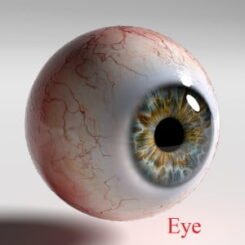Table of Contents
Human Eye
-
The human eye is a complex sense organ that receives visual images and transmits them to the brain.
-
The main function of the eyes is enabling people to see the wonderful world and colors around us.
-
Our eye is the most important optical instrument, which is gifted by God to us.
- The human eye primarily develops from the ectoderm.
-
The shape of the eye is a roughly spherical ball, about 2.5 cm in diameter, located in the eye socket of the skull.
- Without eye, we can’t imagination the beauty of the universal as well as all the other optical instrument would have no value at all !
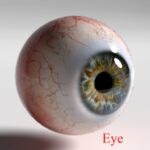
Image: – Human Eye
- The human eye is like a camera, capturing light and converting it into electrical signals that the brain interprets as images.
- The human beings have two eye.
- The human eye works on the refraction of light through a natural convex lens that is made of transparent living material and enables us to see things which are around us.
Definition of Eye or Human Eye
- The human eye is a specialized and sophisticated organ responsible for vision that allows us to perceive and interpret the world through sight.
Working of Human Eye
- The light coming from an object which enters the eye through cornea and the pupil.
- The eye lens converges these light rays to form a real, inverted and highly diminished image on the retina.
- The surface of retina consists of a large number of light delicate cells.
- When light falls on them, it get activated and generate electrical signals.
- These signals are then sent to the brain by the optic nerves, and the observer sees the real and erect image of an object.
Parts of Hume Eye
- The essential parts of the eye are:-
1. Cornea
2. Iris and pupil
3. Ciliary muscles
4. Eye lens
5. Retina
6. Blind spot
1. Cornea
- The front part of the eye is called the cornea.
- It is covered by a transparent spherical membrane.
- The space behind the cornea is loaded up with a clear liquid called aqueous humor.
- Light enters the eye through cornea.
2. Iris and pupil
- The iris and pupil from the variable aperture system of the eye.
- Iris is a dark coloured muscular diaphragm that has a small circular opening in its center.
- The central circular aperture of iris is named pupil.
- The pupil appears black because of no light is reflected from it.
- Iris regulates the amount of light entering the eye by adjusting the size and shape of the pupil.
Working of Iris and pupil
- When light is very bright, the iris makes the pupil to contract. As a result, the amount of light entering in the eye is less.
- When the light is dim, iris makes the pupil to expand. As a result, more light can enter in the eye.
3. Ciliary muscles
- The focal length of the convex lens that presents inside the eye can be changed by the action of the ciliary muscles.
- With the help of ciliary muscles, the focal length of the eye- lens can be changed by changing its shape.
4. Eye lens
- The eye lens is a convex lens made of a soft, flexible and transparent jelly- like proteinaceous materials.
- The eye lens is hard at the middle and gradually becomes soft towards the outer edges.
- Eye lens is held in position by the action of ciliary muscles.
5. Retina
- The screen on which the image is obtained in the eye is called retina.
- The retina is behind the eye – focal point and at the back part of the eye.
- The retina of an eye is similar to just like the film in a camera.
- The retina is a delicate membrane having a large number of light sensitive cells known as “ rods and cones ” that respond to the intensity of light and colour of an objects respectively by producing electrical signals.
- The space between the eye lens and retina is loaded up with another liquid called vitreous humor.
- The image obtained on the retina is retained by it for about 1/16th of a second.
Note
- The eye- lid is present in the front of the eye which is just like the shutter.
- When eye- lid is open, light can enter in the eye but when eye- lid is closed than no light enters in the eye.
6. Blind spot
- There are no rods and cones at where optic nerves leave the eye ball to go to the brain.
- So, if any image is obtained in this part of the retain, then no signal is sent to the brain.
- As a result, the object is not seen.
- This part is therefore termed as the blind spot of the eye.
Layers of Human Eye
- There are three main layers of eye:-
1. Outer layer of eye
2. Middle layer of eye
3. Inner layer of eye
1. Outer layer of eye
- The outer layer of eye is called fibrous tunic.
- It is made out of the sclera and the cornea.
- It provides shape to the eye and support the deeper structures.
- It is a tough, white and opaque membrane.
2. Middle layer of eye
- The middle layer of the eye is known as the vascular tunic or uvea.
- It consists of the choroid, iris, pigmented epithelium and ciliary body.
3. Inner layer of eye
- The innermost layer of the eye is the retain.
- It gets its oxygenation from the blood vessels of the choroid as well as the retinal vessels.
Chambers of Human Eye
- The inside of the human eye, there are three section called chambers. They are named as:-
1. Anterior chamber
2. Posterior chamber
3. Vitreous chamber
1. Anterior chamber
- The anterior chamber is the front part of the eye between the cornea and iris.
- It contains a fluid called aqueous humor.
- Aqueous humor is like water fluid which is produced by the ciliary body. It is continually drained from the eye through the canal of schlemm.
2. Posterior chamber
- The posterior chamber lies between iris and focal point.
- It is also filled with aqueous humor fluid.
- The focal point is held in place by little tissue strands or fibers extending from the inner wall of the eye.
- It provides nutrients to the lens and cornea and maintains pressure.
3. Vitreous chamber
- The vitreous chamber is between the retina and lens.
- It is filled with a thicker jelly- like substance which is called vitreous humor.
- Vitreous humor maintains the shape of the human eye.
Structure of Human Eye
- The eye or human eye is made up of three layers, or coats, enclosing with different anatomical structures.
- The outer layer of the eye is composed of the cornea and sclera which are named as the fibrous tunic.
- Fibrous tunic provides shape to the eye and support the deeper structures.
- The middle layer of the eye is composed of choroid, ciliary body, iris and pigmented epithelium which are named as vascular tunic or uvea.
- Retina is the innermost layer of the eye, it gets its oxygenation from the blood vessels of the choroid as well as retinal vessels.
- The aqueous humor is clear water fluid that is filled in the space of the eye.
- The aqueous humor contained in two areas of the anterior chamber between cornea and iris and the posterior chamber between iris and lens.
- The focal point is suspended to ciliary body by the suspensory ligament which are made up of hundreds of fine transparent fibers.
- It transmit muscular forces to change the shape of the lens for focusing an object.
- Vitreous helps to maintaining the shape of the eye as well as absorb shocks to the eye and keeps the retina appropriately associated with the back wall of the eye.
Shapes of Human Eye
- There are 6 shapes of eye which are named as:-
1. Round eye shape
2. Hooded eye shape
3. Almond eye shape
4. Monolid eye shape
5. Upturned eye shape
6. Downturned eye shape
1. Round eye shape
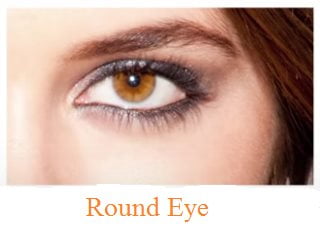
- Round eye shapes are usually large, prominent that looks more circular.
- Its cornea is surrounded by white all the way around.
- Their inner and outer corners are rounded and not pulled inward or outward.
2. Hooded eye shape
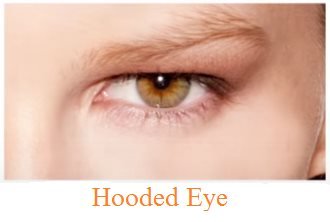
- Hooded eye shape has a heavy brow bone with a deep set crease.
- If hooded eye is open, eyelid is not generally visible and retracts into the crease.
- When we are aged, our eyelid space has diminished, taking on a hooded appearance.
3. Almond eye shape
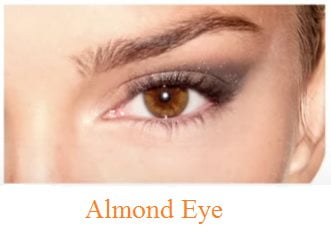
- It is just like an almond in a shape.
- They have a smaller eyelid and are longer in width than they are round.
- Their shape is taper to a point by the tear duct and the outer eye.
- Its outer part of the cornea is generally hidden under the top and bottom lids.
- It is also an apparent crease.
4. Monolid eye shape
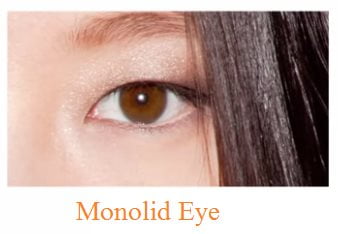
- The feature of monolid eye is a less apparent crease.
- The shapes of Asian women eye is similar to the monolid eye.
- They having often called a shallow or smooth eyelid.
- They don’t reveal as much if any of the eyelid.
5. Upturned eye shape
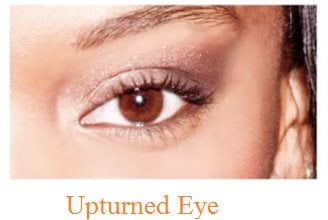
- It has outer corners that turn upward and higher than the inner corner.
- They are basically opposite of downturned eye.
- It is also known as ‘ cat eye ‘.
- Its tilt upward and giving the eye an exotic appearance.
- Their bottom lash line is curve upward to meet the top lashes at the outer corner of the eye.
6. Downturned eye shape
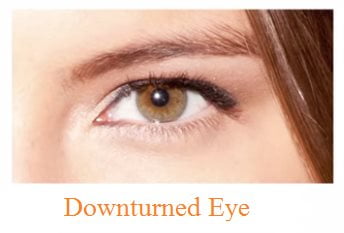
- It is also named as a ‘ descending eyelid ‘.
- Their upper lid that dips to meet the lower lash line and the outer corners are lower than the inner corner.
Accommodation of Human Eye
- The property by which eye lens is able to change its focal length is named as accommodation.
- The eye can focus the images of all the objects either distant or nearby at the same place by changing the focal length of its lens.
- When the eye is focused on distant objects than ciliary muscle is fully relaxed.
- When ciliary muscle is in the relaxed state, the thickness of the lens is minimum and focal length is maximum that is equal to the distance of the retina from the eye lens.
- If the parallel rays coming from any distant object are focused on the retina than object is seen clearly.
- When the human eye is focused on a nearby object than ciliary muscle gets tense.
- Tension in the ciliary muscle is decreases focal length of eye lens by slightly increasing its thickness in such a way that the images are formed on retina.
- Hence, eye focuses on the nearby objects by tensing the ciliary muscle.
- All these adjustments in the focal length of eye lens take place so fast that we don’t realise such changes.
Limit of Accommodation
- The human eye can accommodate only up to a limit.
- A normal human eye can accommodate up to the least distance of distinct vision of about 25cm from the eye.
- If an objects which are very close to the eye produce blurred image.
- Thus, a normal human eye can accommodate an objects lying between infinity and the least distance of distinct vision as close as 25cm.
- The accommodation of human eye for a person having normal vision is about 4 dioptres.
Defects of Human Eye Vision
- In this cases the vision of a person becomes blurred and he can’t see either the distant and nearby objects clearly. Then person is said to have a defect of vision or defect of eye.
- There are three common defects of vision which are named as:-
1. Myopia
2. Hypermetropia
3. Presbyopia
1. Myopia
- Myopia is that defect of eye due to which a person can’t see the distant objects clearly though it can see the nearby objects clearly.
- In other word myopia is also called as short sightedness or near sightedness.
- It is caused by:-
- Due to high converging power of eye lens.
- Due to eye ball being too long.
- Myopia can be corrected by using spectacles which is made from concave lenses.
- Here, the purpose of using a concave lens is to decreases the converging power of the human eye lens and help in forming the image of distant object on the retina of myopia eye.
2. Hypermetropia
- Hypermetropia is that defect of eye due to which a person can’t see the nearby objects clearly though it can see the distant objects clearly.
- In other word hypermetropia is also called as long-sightedness.
- It is just opposite of myopia.
- It is caused by:-
- Due to the low converging power of eye lens.
- Due to eye ball being too short.
- Hypermetropia can be corrected by making spectacles which is made from convex lenses.
- Here, the purpose of using a convex lens is to increase the converging power of the human eye lens and help in forming the image of nearby object on the retina of hypermetropia eye.
3. Presbyopia
- Presbyopia is that defect of eye due to which an old person can’t see the nearby objects clearly due to loss of power of accommodation of eye.
- It is caused by:-
- Due to the loss of power of accommodation of the eye i.e., weakening of the ciliary muscle.
- Due to the hardening of the eye lens.
- Presbyopia can be corrected by making spectacles which is made from convex lens.
- It is also possible that the same person has both myopia as well as hypermetropia defects of vision.
- When the person suffering from both defects uses spectacles having bifocal lenses.
- In which upper part consists of a concave lens used for distant vision and lower part consists of a convex lens used for reading purposes.
Let’s Know More
1. When the human eye is said to be unaccommodated ?
Ans :- When the human eye is looking at a distant object than the eye is said to be unaccommodated due to the relaxed state of the eye.
2. What is far point?
Ans:- The farthest point from the human eye at which an object can be seen clearly is called as the far point of the eye.
3. What is near point?
Ans:- The nearest point up to which human eye can see an object clearly without any strain is known as near point.
4. What is least distance of distinct vision?
Ans:- The minimum distance at which an object must be placed so that a normal eye may be see it clearly without any stain is known as least distance of distinct vision.
5. What is colour blindness?
Ans:- Colour blindness is that defect of the eye due to which a person is not able to distinguish between certain colours. It is a genetic disorder that occurs because of inheritance.
6. What is vision?
Ans:- The ability to see is known as vision. This is also known as eyesight or drishti in Hindi.
7. Give two point why we have two Eyes for vision and not just one.
Ans:- There are so many advantages of having two eyes instead of one. Some of them are as follows:-
- It gives a wider field of view.
- It enables us to judge distances more accurately.
8. What happens to the image distance in the human eye if we increase the distance of an object from the eye?
Ans:- The image distance in the eye remains the same when we increase in the distance of an object.
- It is compensated by change in the focal length of the eye lens caused by the action of the ciliary muscle.
